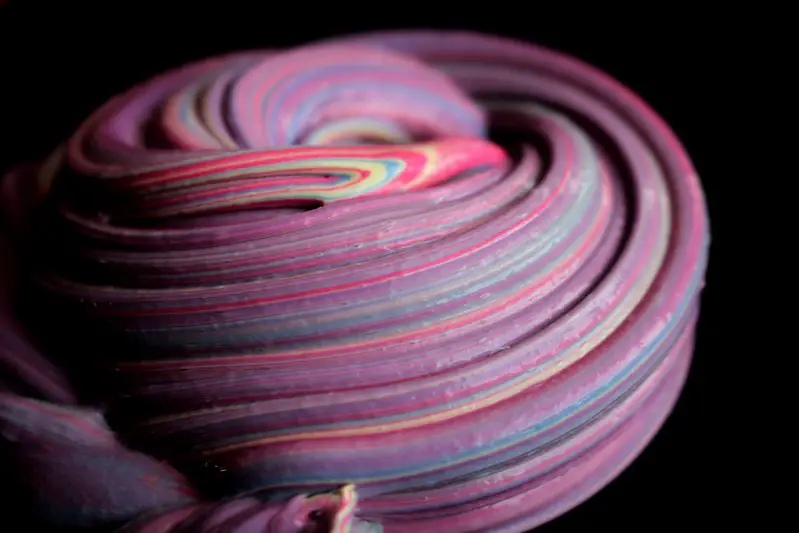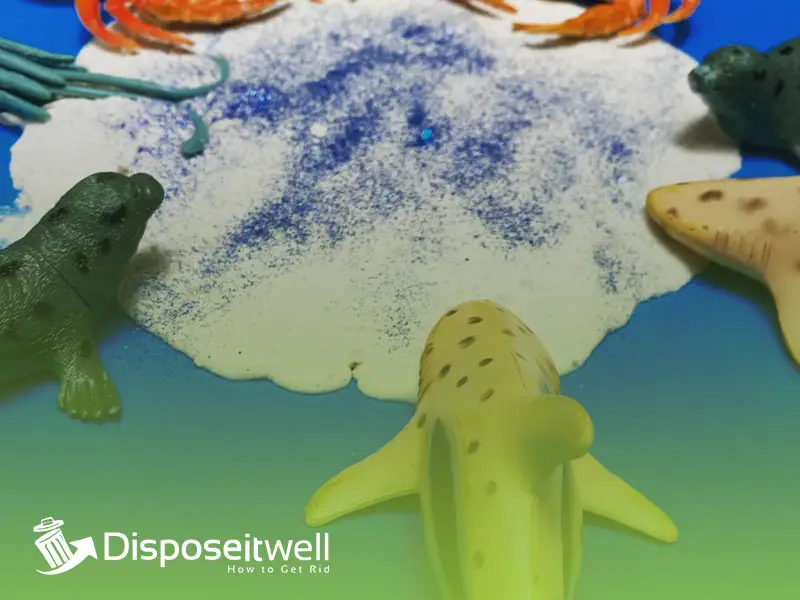Are you done with slime and looking for the best and safe way to dispose of it without affecting the environment? Don’t worry! This article highlights some of the best and safest methods to dispose of slime without impacting the ecosystem.
Slime is a substance with numerous uses, such as teaching (demonstrating polymers, chemical reactions, or viscosity), and playing. This means you must learn the appropriate ways to dispose of it without leaving allergens. Disposing of slime needs preparation.
Otherwise, it will impact the environment negatively. The first method people think of when it comes to disposing of products is recycling. So, can you recycle slime? Well, the answer to this question depends on the regulations of your local recycling facility. Sometimes, you can take your waste slime to these facilities for recycling.
You may be required to pay for these services. Other methods of disposing of slime include cutting it into pieces and then spreading it in the garden (for biodegradable slime only); keep using it or donate it.
Is Slime Biodegradable?
Slime is non-biodegradable, but you can make your biodegradable version. The non-biodegradable nature of slime is thanks to the addition of borax which bears this feature. Therefore, when you dispose of slime made of borax to the surrounding, it does not disintegrate due to the action of time, natural elements, and microorganisms; hence it is not eco-friendly. You need thorough preparation to dispose of non-biodegradable slime to avoid harming the environment.
Biodegradable slime quickly decomposes when natural elements, time, or microorganisms act on it. Such slime is not only harmless but also beneficial to the environment. Natural elements such as heat, water, and air may act together with microorganisms to disintegrate biodegradable slime within a few weeks.
The biodegradability of slime depends on the materials used to make it. For instance, making slime at home using wood makes it biodegradable and therefore cannot harm the surrounding. However, if it features compounds such as long-chain polymer molecules (polyvinyl alcohol), it becomes non-biodegradable. This is the substance that gives slime its oozy and gooey nature.
Although materials used to manufacture slime seem harmless, however some, such as polyvinyl alcohol and borax, are not. Polyvinyl alcohol can only be bio-degraded under anaerobic conditions. However, the same can’t apply to borax, the greatest product that makes slime non-biodegradable.
Borax (sodium tetra-borate) is a colourless crystal that readily dissolves in water. It is responsible for giving slime its consistency thanks to its thickness. The high boron consent in borax makes it harmful to the environment. Although slime is non-biodegradable, it can decompose for a long time. However, this time may allow it to pile up, making it dangerous to the environment. For instance, if boron finds a way to water bodies, it may kill marine life. Therefore, throwing slime in a trash can is not a feasible idea.
How to Dispose of Slime?

The following are some of the main methods of disposing of slime:
Cutting into Pieces Before Throwing in the Garden
Throwing a massive block of slime in the garden is not feasible. It will take a long time to disintegrate and decompose and also harm the environment by collecting other harmful substances on it. Cutting and crushing the slime block into small pieces is the best way of disposing of large slime blocks. After cutting the slime blocks into small pieces, you can mix them with your household waste and spread them in your garden (for homemade biodegradable slime).
Reach out to the Local Recycling Center
Contact a local recycling facility near you if you are using industrial slime and are worried about harming the environment. They will help you safely dispose of your industrial slime without harming the ecosystem.
They will also guide you to a safe place to dispose of either industrial or homemade slime. All local recycling facilities require gear and knowledge on how to dispose of the slime without harming the environment. Most facilities require you to take the slime block or pieces and the remaining waste liquid to them. They will then decide what to do with it after that. Depending on the recycling facility, they can dispose of the slime for free or charge you some cash, so you must be prepared for any scenario.
Use It for as Long as You Can
Instead of disposing of slime after every month, make sure you take good care of it so that it can be helpful for a long time. Slime degrades either by shrinking due to layers piling upon one another or other layers. Your van prevents slime from shrinking and degrading; make sure you store it in the original container after every use. Exposure to air and other elements in the air causes slime to solidify and lose its elasticity. Storing it in the original container and sealing it prevents these reactions; hence keeping your slime in better quality and storing it correctly after every use leaves you with a small piece of slime at the end that is easy to dispose of compared to a larger block.
Donating
If you have more slime than you can use (whether industrial or homemade), you can donate it to those who need it. You can look for children from your relatives, friends, or neighbors who enjoy using slime and give them some. If you are mass producing it, you can contact a kindergarten school and offer it to them for learning and entertainment purposes. Besides schools, you can reach out to children’s warfare centres or an orphanage that may accept your slime donation.
Things to Avoid While Disposing of Slime
Do not dispose of slime irresponsibly. The following are some things to take note of when disposing of slime:
- Do not dispose of slime in the drainage system, such as the toilet or sink because it motivates the growth of bacteria that may cause infections to spike. Besides, it may clog the pipes.
- When making homemade slime, do not use hazardous ingredients (both for you and the environment). Safe ingredients include PVA glue while harmful ones include borax and glitter.
How to Up Cycling Slime?

If you have more slime you are not using, mould it into attractive figures to decorate your home. For instance, you can mould transparent slime into figures you can hold onto to reduce stress. You can also use it to make your phone shiny and attractive. Slime dries when it solidifies. You can mould it into a fine work of art before that happens. You can also dry clime on top of old jars to make beautiful suncatchers.
Repurposing Your Slime
Slime can be repurposed easily. Starting with making slime jars and containers which you can reuse and recycle however much you like. Jars or containers made of slime can be used to hold crafts for a long time since they have a long shelf life. Moreover, jars and containers made of slime are food grade and hence can be used as sugar or salt containers
How to Fix Your Slime?
If slime dries accidentally, you can restore its elasticity by doing a few things:
- Heat it at a moderate temperature and knead it like dough, continue kneading it until its elasticity restores.
- Use hair gel, foaming soap, or shampoo to make it as stretchy as it was initially.
Frequently Asked Questions about Slime
Is Slime Bad for the Environment?
Generally, slime made of borax is harmful to the environment. Slime consisting of borax cannot harm the environment immediately after it is disposed of. It takes at least ten years to disintegrate.
When it does, it becomes lethal to the environment, the soil being the first victim. If it is washed down to water bodies, it brings damage hence aquatic life becomes threatened when they are ingested. Therefore, the effects of slime on the environment cannot be ignored
Is Slime Safe for Kids?
Slime is crucial for a child’s overall development. It is safe for kids if it is not ingested (biodegradable and non-biodegradable slime). Although borax is harmful to the environment in numerous ways, it can’t negatively impact your kids if they keep away from ingesting it.
However, once it is ingested, it reacts with acids in the stomach thus unleashing its potency. After a kid ingests biodegradable slime, they will develop symptoms such as irrigation, vomiting, diarrhoea etc. The lethality of non-biodegradable slime after ingestion depends on how much the kid has consumed.
How Long Does Slime Last?
The longevity of slime depends on where it is manufactured. For example, slimes made from industries have longevity chemicals that make them last longer. Biodegradable slime made at home does not have such longevity chemicals; therefore, it gets spilt faster.
Overall, homemade slime can last for at least a month, giving you time to prepare another batch. Industrial slime lasts long (at least four years) thanks to the longevity of chemicals; provided that the slime is stored in the original packaging and kept in a cool and dry place.
Can You Put Slime in the Fridge?
Slime encourages the growth of moulds. Therefore, industrial or homemade slime must be stored under social conditions. The growth of mould may destroy the slime. You can store your slime in the freezer to prevent such from occurring.
However, before storing it, ensure it is stored in an airtight container or plastic bag. Homemade slime can last for at least two months in the freezer. The mold growth shows that your slime is ineffective and should be disposed of carefully.
Verdict
Disposing of slime is easy. Since it is non-biodegradable except for homemade slime, make sure you dispose of it responsibly. The most straightforward methods to dispose of it are cutting it in pieces, donating it, taking it to the local recycling center, or taking good care of it so you can use it. Slime provides fun, especially for people who love art. Moreover, it is therapeutic and can relieve stress and other anxiety-related effects.

Gemma Alexander has an M.S. in urban horticulture and a backyard filled with native plants. After working in a genetics laboratory and at a landfill, she now writes about the environment and recycling topics.

